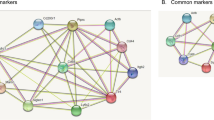Abstract
Pig alveolar macrophages are a heterogeneous population of cells. Three subpopulations or bands exist when the whole population is separated according to density. Band 1 cells are the least dense cells and constitute 9% of the total population. Bands 2 and 3 represent 44 and 47% of the total population. The three subpopulations generate superoxide anions, although to varying degrees. Band 3 cells are the most active, while band 1 cells are the least active. The amount of superoxide anions released in a mixed population of bands 1, 2, and 3 cells was less than the sum of that produced from each band assayed separately. Band 1 cells were found to inhibit by 47% the production of superoxide anions by band 3 cells. Conditioned medium from band 1 cells contains a heat-sensitive, nondialyzable, soluble factor responsible for this inhibition.
Similar content being viewed by others
References
Chandler, D., N. Fuller, R. Jackson, andJ. Fulmer. 1986. Studies of membrane receptors and phagocytosis in subpopulations of rat alveolar macrophages.Am. Rev. Respir. Dis. 133:461–467.
Chandler, D., N. Fuller, R. Jackson, andJ. Fulmer. 1986. Fractionation of rat alveolar macrophages by isopycnic centrifugation. Morphology, cytochemical, biochemical and functional properties.J. Leukocyte Biol. 39:371–384.
Kaelin, R., D. Center, J. Bernardo, M. Grant, andG. Snider. 1983. The role of macrophage derived chemoattractant activity in the daily inflammatory events of bleomycin-induced pulmonary injury.Am. Rev. Respir. Dis. 128:132–138.
Kaltreider, H. 1982. Alveolar macrophages. Enhancers or suppressors of pulmonary immune reactivity?Chest 82:261–266.
Brain, J., D. Golde, G. Green, D. Mazzaro, P. Ward, andZ. Werb. 1978. Biological potential of pulmonary macrophages.Am. Rev. Respir. Dis. 118:435–439.
Hocking, W. andD. Gold. 1979. The pulmonary alveolar macrophage.N. Engl. J. Med. 301:580–583.
Hooper, K., andJ. Cahill. 1983. Immunoregulation by macrophages II. Separation of mouse peritoneal macrophages having tumoricidal and bactericidial activities from those secreting PGE and interleukin I.J. Reticuloendothel. Soc. 33:443–448.
Becker, J. andR. Grasso. 1985. Suppression of phagocytosis by dexamethasone in macrophage culture: Inability of arachidonic acid, indomethacin and nordihydroguaiaretic acid to reverse the inhibitory response mediated by a steroid inducible factor.Int. J. Immunopharmacol. 7:839–847.
Jutila, M., andK. McIver. 1986. Release of chemotactic monokine upon treatment with lymphocyte supernatants.J. Leukocyte Biol. 39:533–595.
Zeidler, R. B., andN. S. Conley. 1986. Superoxide generation by pig alveolar macrophages.J. Comp. Biochem. Physiol. 85B: 101–104.
Dauber, J., A. Holian, M. Rosemiller, andR. Daniele. 1983. Separation of bronchoalveolar cells from the guinea pig on continuous density gradients of percoll: Morphology and cytochemical properties of fractionated lung macrophages.J. Reticuloendothel. Soc. 33:119–126.
Zeidler, R., andH. Kim. 1985. Phagocytosis, chemiluminescence and cell volume of alveolar macrophages from neonatal and adult pigs.J. Leukocyte Biol. 37:29–43.
Tritsch, G., andP. Niswander. 1982. Positive correlations between superoxide release and intracellular adenosine deaminase activity during macrophage membrane perturbation regardless of magnitude of stimulus.Mol. Cell. Biochem. 49:49–51.
Holt, P. 1986. Down-regulation of immune responses in the lower respiratory tract. The role of alveolar macrophages.Clin. Exp. Immunol. 63:261–270.
Shellito, J., andH. Kaltreider. 1984. Heterogeneity of immunologic function among subfractions of normal rat alveolar macrophages.Am. Rev. Respir. Dis. 129:747–753.
Holian, A., J. Dauber, M. Diamond, andR. Daniele. 1983. Separation of bronchoalveolar cells from guinea-pig on continuous gradients of percoll: Functional properties of fractionated lung macrophages.J. Reticuloendothel. Soc. 33:157–164.
Ishibashi, Y., andT. Yamashita. 1985. Purification and characterization of a phagocytosisstimulating factor from phagocytosing polymorphonuclear neutrophils: Comparison with granule basic proteins.Infect. Immun. 48:799–805.
Takemura, R., andZ. Werb. 1984. Secretory products of macrophages and their physiological functions.Am. J. Physiol. 246:C1–9.
Author information
Authors and Affiliations
Rights and permissions
About this article
Cite this article
Zeidler, R.B., Flynn, J.A., Arnold, J.C. et al. Subpopulation of alveolar macrophages inhibits superoxide anion production by macrophages. Inflammation 11, 371–379 (1987). https://doi.org/10.1007/BF00915841
Issue Date:
DOI: https://doi.org/10.1007/BF00915841



